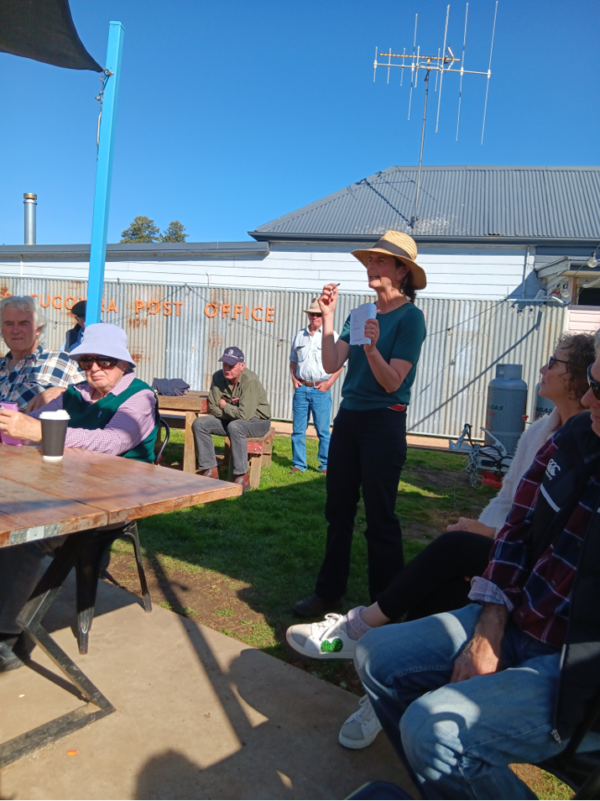In November 2022, what has been described as a one-in-5,000 year flood, or an “inland tsunami”, occurred in the Central Western New South Wales town of Eugowra, causing the tragic deaths of two people and destruction to eighty percent of the homes and businesses of the town’s 500 residents.
Since 2021, the Institute’s Integral Ecology Strategic Plan has called for the Institute to be involved in at least one practical, on the-ground project per year. One aim of these projects is to offset the Institute’s carbon footprint, whilst at the same time making a positive and lasting difference at a landscape and community level. In past years, the Institute has led a creek rejuvenation project in Oamug in Papua New Guinea and a rainforest management plan at the Seville Mercy Conference Centre in Cairns.
In June this year, the Institute Leadership Team, following a recommendation by the Institute’s Integral Ecology Animator, Sally Neaves, decided that the Institute’s project for the coming year would be to assist the people of Eugowra in their quest to ‘sink, slow and spread’ the water from the Mandagery Creek to mitigate future flood events. Since then she has been working with multiple stakeholders, including residents, farmers, community groups and government on a path forward.
“Working with the local community, we have sought to widen our focus on the catchment to sink spread and slow the water, providing a buffer against future floods, fires, drought and dust storms.
“While many in the community were initially sceptical about being able to mitigate against these disasters, thankfully they are now saying ‘we at least have to try’.
“Some are saying even if we can slow future flood events, it could make a big difference. In the last year’s flood the previously held wisdom of 7-10 hours notice of the flood coming was replaced by only 1-1.5 hours notice, meaning many people were unable to flee to safety,” said Sally.
Moving much of the town of Eugowra to higher ground has been mooted as one action that could be taken. Over the past few months, Sally and a panel of experts have been leading a conversation with the community seeking to find a more encompassing response.
“Following these conversations, Eugowra is now looking to follow in the footsteps of drought and flood-impacted communities such as Lismore by addressing the root causes of flood and drought through restoring the creeks and river systems ability to slow, sink and spread water naturally.
“Using methods pioneered by The Australian Landscape Science Institute, Tarwyn Park Training, and The Mulloon Institute, the aim is to restore the landscape using nature’s blueprint, combined with new housing options better designed for disaster adaptation.
“The combination of these elements is to provide communities with the best chance to flourish and adapt to future disasters,” said Sally.
Not unexpectedly, Sally says it has taken a fair few months to get a team together and to be able to garner community support for a wider ‘root cause’ response. This work culminated in a meeting at the end of August which brought together landholders, farmers, community groups, local elected representatives as well as expert advisors.
“It was an important meeting because collectively we affirmed the need for education, awareness raising and capacity building.
“To this end, I am now co-designing an education program, for which the Institute has gratefully received some initial funding from the Douglas Foundation, to develop and roll out,” said Sally.
The program will incorporate visits to other areas to view best practice creek rehabilitation, as well as an introductory workshop, a two day boot camp and visits to local farms and properties.
“If successful, the program could become a ‘lighthouse’ response that may be able to be adopted in other areas, potentially saving livelihoods and lives.


“In getting to know the Eugowra community, my approach has always been and will continue to be, one of not trying to tell anyone what to do, as certainly no one person has all of the possible answers.
“Instead, it has been one of bringing different voices to the table so that we could determine a pathway forward, which is what was done at the August meeting.
“Many of the locals knew of the Sisters of Mercy, however they were not aware of our commitment to integral ecology and they were pleasantly surprised that the Institute was prepared to put words into action through supporting important projects such as this one,” said Sally.
For the story and to watch a video about the project go to Helping to slow the flow in Eugowra | Institute of the Sisters of Mercy of Australia
Published with the permission of the Institute of the Sisters of Mercy
